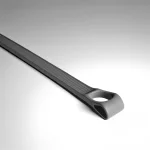Cable ties are an essential tool in various industries, from electrical installations to agriculture. Understanding the physics of cable ties tensile strength is crucial for ensuring safety and efficiency in their application. This article delves into the material science behind cable ties, offering insights into how their tensile strength is determined and why it matters.
Understanding tensile strength in cable ties
Tensile strength is a key performance indicator for cable ties. It refers to the maximum load a cable tie can handle before breaking. This strength is influenced by the material composition and the manufacturing process. Nylon 6/6, a type of polyamide, is commonly used due to its balance of strength and flexibility. The molecular structure of this material provides resistance to environmental factors, contributing to the overall durability of the cable tie.
Material science of cable ties
The material science of cable ties is fascinating. It involves the use of polymers that are engineered to withstand various stresses. Nylon 6/6, for instance, is known for its high tensile strength, which is achieved through a process called polymerization. This process links monomers into long chains, creating a material that can endure significant force without breaking.
Factors affecting tensile strength

Several factors affect the tensile strength of cable ties. The width and thickness of the tie play a crucial role, as does the type of locking mechanism used. Environmental conditions such as temperature and exposure to chemicals can also impact the tensile strength. Manufacturers must consider these factors to ensure that cable ties perform reliably under expected conditions.
Cable tie variations and their strengths
Cable ties come in various types, each with different tensile strengths. Standard cable ties typically have a tensile strength of around 50 lbs, while heavy-duty versions can handle up to 175 lbs or more. Stainless steel cable ties offer even greater strength, making them suitable for more demanding applications.
Testing and standards for cable tie tensile strength
Cable tie tensile strength is rigorously tested to meet industry standards. The International Electrotechnical Commission's IEC 62275 standard outlines the requirements for cable tie testing. This includes pull tests to failure and tests at declared tensile loads. These standards ensure that cable ties are reliable and safe for use in various applications.
The role of tensile strength in applications
The tensile strength of cable ties is critical in applications where safety and reliability are paramount. In construction, for example, cable ties must be able to support the weight of cables without risk of failure. In agriculture, they must withstand the forces exerted by plants and weather conditions. Choosing the right cable tie with the appropriate tensile strength is essential for the success of these applications.
Advancements in cable tie materials
Advancements in material science have led to the development of cable ties with improved tensile strengths. New materials and manufacturing techniques have resulted in cable ties that are stronger and more resilient to environmental factors. These advancements ensure that cable ties can meet the increasing demands of modern applications.
Materials and tensile strength of cable ties
nylon
Nylon cable ties are lightweight and durable, with a tensile strength ranging from 18 to 250 pounds. They resist abrasion and chemicals.
stainless steel
Stainless steel cable ties offer high tensile strength, typically over 100 pounds, and excel in harsh environments. They resist corrosion and heat.
polypropylene
Polypropylene ties are less durable, with tensile strengths around 50 to 120 pounds. They work well in chemical exposure areas.
aluminum
Aluminum cable ties are lightweight with moderate strength, generally around 90 to 150 pounds. They are excellent for outdoor use.
teflon
Teflon cable ties withstand extreme temperatures and chemical exposure, with tensile strengths usually between 30 and 80 pounds.
kevlar
Kevlar cable ties provide exceptional durability and high tensile strength, often exceeding 200 pounds. They are ideal for high-stress applications.
velcro
Velcro cable ties offer adjustable and reusable options with lower tensile strength, typically under 50 pounds. They are perfect for delicate cables.
Conclusion
Cable ties are a small but mighty tool in the world of fastening and bundling. Their tensile strength, determined by material science and manufacturing processes, is a testament to the importance of understanding the physics behind these everyday items.
Whether you're a professional installer or a DIY enthusiast, recognizing the significance of tensile strength in cable ties can lead to safer and more effective use. Explore our website to learn more about the innovative uses of cable ties in various industries.

